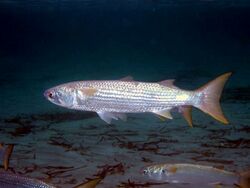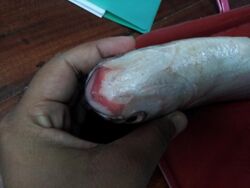Biology:Mullet (fish)
| Mullet | |
|---|---|

| |
| Mugil cephalus | |
| Scientific classification | |
| Domain: | Eukaryota |
| Kingdom: | Animalia |
| Phylum: | Chordata |
| Class: | Actinopterygii |
| (unranked): | Acanthomorpha |
| Superorder: | Acanthopterygii |
| Clade: | Percomorpha |
| (unranked): | Ovalentaria |
| Order: | Mugiliformes |
| Family: | Mugilidae Jarocki, 1822 |
| Type species | |
| Mugil cephalus Linnaeus, 1758
| |
| Genera | |
|
See text. | |
The mullets or grey mullets are a family (Mugilidae) of ray-finned fish found worldwide in coastal temperate and tropical waters, and some species in fresh water.[1] Mullets have served as an important source of food in Mediterranean Europe since Roman times. The family includes about 78 species in 20 genera.[2]
Mullets are distinguished by the presence of two separate dorsal fins, small triangular mouths, and the absence of a lateral line organ. They feed on detritus, and most species have unusually muscular stomachs and a complex pharynx to help in digestion.[1]
Classification and naming
Taxonomically, the family is currently treated as the sole member of the order Mugiliformes, but as Nelson says, "there has been much disagreement concerning the relationships" of this family.[3] The presence of fin spines clearly indicates membership in the superorder Acanthopterygii, and in the 1960s, they were classed as primitive perciforms,[4] while others have grouped them in Atheriniformes.[5] They are classified as an order, Mugiliformes, within the subseries Ovalentaria of the clade Percomorpha in the 5th Edition of Fishes of the World.[6]
In North America, "mullet" by itself usually refers to Mugilidae. In Europe, the word "mullet" is usually qualified, the "grey mullets" being Mugilidae and the "red mullets" or "surmullets" being Mullidae, notably members of the genus Mullus.[7] Outside Europe, the Mullidae are often called "goatfish".[8] Fish with common names including the word "mullet" may be a member of one family or the other, or even unrelated such as the freshwater white sucker (Catostomus commersonii).[9]
However, recent taxonomic work has reorganised the family and the following genera make up the Mugilidae:[10][11]
- Agonostomus Bennett, 1832
- Aldrichetta Whitley, 1945
- Cestraeus Valenciennes, 1836
- Chaenomugil Gill, 1863
- Chelon Artedi, 1763
- Crenimugil Schultz, 1946
- Dajaus Valenciennes, 1836
- Ellochelon Whitley, 1930
- Gracilimugil Whitley, 1941
- Joturus Poey, 1860
- Minimugil Durand, Chen, Shen, Fu & Borsa, 2012
- Mugil Linnaeus, 1758
- Myxus Günther, 1861
- Neomyxus Steindachner, 1878
- Neochelon Durand, Chen, Shen, Fu & Borsa 2012
- Oedalechilus Fowler 1903
- Osteomugil G. Luther, 1982
- Parachelon Durand, Chen, Shen, Fu & Borsa 2012
- Paramugil Ghasemzadeh, Ivantsoff & Aarn 2004
- Planiliza Whitley, 1945
- Plicomugil Schultz, 1953
- Pseudomyxus Durand, Chen, Shen, Fu & Borsa 2012
- Rhinomugil Gill, 1863
- Sicamugil Fowler, 1939
- Squalomugil Ogilby, 1908
- Trachystoma Ogilby, 1888
Behaviour
A common noticeable behaviour in mullet is the tendency to leap out of the water. There are two distinguishable types of leaps: a straight, clean slice out of the water to escape predators and a slower, lower jump while turning to its side that results in a larger, more distinguishable, splash. The reasons for this lower jump are disputed, but have been hypothesised to be in order to gain oxygen rich air for gas exchange in a small organ above the pharynx.[12]
Development
The ontogeny of mugilid larvae has been well studied, with the larval development of Mugil cephalus in particular being studied intensively due to its wide range of distribution and interest to aquaculture.[13] The previously understudied osteological development of Mugil cephalus was investigated in a 2021 study, with four embryonic and six larval developmental steps being described in aquaculture-reared and wild-caught specimens.[13] These descriptions provided clarification of questionable characters of adult mullets and revealed informative details with potential implications for phylogenetic hypotheses, as well as providing an overdue basis of comparison for aquaculture-reared mullets to enable recognition of malformations.[13]
Timeline
<timeline> ImageSize = width:1000px height:auto barincrement:15px PlotArea = left:10px bottom:50px top:10px right:10px
Period = from:-65.5 till:10 TimeAxis = orientation:horizontal ScaleMajor = unit:year increment:5 start:-65.5 ScaleMinor = unit:year increment:1 start:-65.5 TimeAxis = orientation:hor AlignBars = justify
Colors =
#legends id:CAR value:claret id:ANK value:rgb(0.4,0.3,0.196) id:HER value:teal id:HAD value:green id:OMN value:blue id:black value:black id:white value:white id:cenozoic value:rgb(0.54,0.54,0.258) id:paleogene value:rgb(0.99,0.6,0.32) id:paleocene value:rgb(0.99,0.65,0.37) id:eocene value:rgb(0.99,0.71,0.42) id:oligocene value:rgb(0.99,0.75,0.48) id:neogene value:rgb(0.999999,0.9,0.1) id:miocene value:rgb(0.999999,0.999999,0) id:pliocene value:rgb(0.97,0.98,0.68) id:quaternary value:rgb(0.98,0.98,0.5) id:pleistocene value:rgb(0.999999,0.95,0.68) id:holocene value:rgb(0.999,0.95,0.88)
BarData=
bar:eratop bar:space bar:periodtop bar:space bar:NAM1 bar:NAM2
bar:space bar:period bar:space bar:era
PlotData=
align:center textcolor:black fontsize:M mark:(line,black) width:25 shift:(7,-4) bar:periodtop from: -65.5 till: -55.8 color:paleocene text:Paleocene from: -55.8 till: -33.9 color:eocene text:Eocene from: -33.9 till: -23.03 color:oligocene text:Oligocene from: -23.03 till: -5.332 color:miocene text:Miocene from: -5.332 till: -2.588 color:pliocene text:Plio. from: -2.588 till: -0.0117 color:pleistocene text:Pleist. from: -0.0117 till: 0 color:holocene text:H.
bar:eratop from: -65.5 till: -23.03 color:paleogene text:Paleogene from: -23.03 till: -2.588 color:neogene text:Neogene from: -2.588 till: 0 color:quaternary text:Q.
PlotData=
align:left fontsize:M mark:(line,white) width:5 anchor:till align:left
color:oligocene bar:NAM1 from: -33.9 till: 0 text: Mugil color:miocene bar:NAM2 from: -23.03 till: 0 text: Liza
PlotData=
align:center textcolor:black fontsize:M mark:(line,black) width:25
bar:period from: -65.5 till: -55.8 color:paleocene text:Paleocene from: -55.8 till: -33.9 color:eocene text:Eocene from: -33.9 till: -23.03 color:oligocene text:Oligocene from: -23.03 till: -5.332 color:miocene text:Miocene from: -5.332 till: -2.588 color:pliocene text:Plio. from: -2.588 till: -0.0117 color:pleistocene text:Pleist. from: -0.0117 till: 0 color:holocene text:H.
bar:era from: -65.5 till: -23.03 color:paleogene text:Paleogene from: -23.03 till: -2.588 color:neogene text:Neogene from: -2.588 till: 0 color:quaternary text:Q.
</timeline>
References
- ↑ 1.0 1.1 Johnson, G.D.; Gill, A.C. (1998). Paxton, J.R.. ed. Encyclopedia of Fishes. San Diego: Academic Press. p. 192. ISBN 978-0-12-547665-2.
- ↑ "Family Mugilidae - Mullets". Fishbase. http://www.fishbase.org/summary/FamilySummary.php?ID=359.
- ↑ "Fishes of the World, 4th Edition". Wiley. http://www.wiley.com/WileyCDA/WileyTitle/productCd-0471250317.html.
- ↑ Gosline, W. A. (1961) "The Perciform Caudal Skeleton" Copeia 1961(3): pp. 265–270
- ↑ O.H. Oren (1981). Aquaculture of Grey Mullets. CUP Archive. p. 2. ISBN 9780521229265.
- ↑ J. S. Nelson; T. C. Grande; M. V. H. Wilson (2016). Fishes of the World (5th ed.). Wiley. pp. 752. ISBN 978-1-118-34233-6. https://sites.google.com/site/fotw5th/. Retrieved 2018-10-25.
- ↑ "Mullet species". britishseafishing.co.uk. 14 September 2012. http://britishseafishing.co.uk/mullet-species/.
- ↑ "Goatfish". Encyclopædia Britannica. https://www.britannica.com/animal/goatfish.
- ↑ "Common names of Catostomus commersonii". Fishbase. http://www.fishbase.org/ComNames/CommonNamesList.php?ID=2965&GenusName=Catostomus&SpeciesName=commersonii&StockCode=3161.
- ↑ Jean-Dominique Durand; Wei-Jen Chen; Kang-Ning Shen; Cuizhang Fue; Philippe Borsaf (2012). "Genus-level taxonomic changes implied by the mitochondrial phylogeny of grey mullets (Teleostei: Mugilidae) (abstract)". Comptes Rendus Biologies 335 (10&11): 687–697. doi:10.1016/j.crvi.2012.09.005. PMID 23199637. http://hal.ird.fr/ird-00759075/file/Durand_et_al_Mugilidae_1bis_p._HAL.pdf.
- ↑ Froese, Rainer, and Daniel Pauly, eds. (2021). "Mugilidae" in FishBase. February 2021 version.
- ↑ Hoese, Hinton D. (1985). "Jumping mullet — the internal diving bell hypothesis" (in en). Environmental Biology of Fishes 13 (4): 309–314. doi:10.1007/BF00002915.
- ↑ 13.0 13.1 13.2 Thieme, Philipp; Vallainc, Dario; Moritz, Timo (2021). "Postcranial skeletal development of Mugil cephalus (Teleostei: Mugiliformes): morphological and life-history implications for Mugiliformes". Zoological Journal of the Linnean Society 192 (4): 1071–1089. doi:10.1093/zoolinnean/zlaa123. https://academic.oup.com/zoolinnean/article/192/4/1071/5952425.
Further references
- J.S. Nelson, Fishes of the World. ISBN:978-0-471-25031-9.
- Sepkoski, Jack (2002). "A compendium of fossil marine animal genera". Bulletins of American Paleontology 364: 560. http://strata.ummp.lsa.umich.edu/jack/showgenera.php?taxon=611&rank=class. Retrieved 2011-05-19.
- Eschmeyer, William N.; Fricke, Ron; van der Laan, Richard, eds. "Genera in the family Mugilidae". California Academy of Sciences. http://researcharchive.calacademy.org/research/ichthyology/catalog/fishcatget.asp?tbl=genus&family=Mugilidae.
External links
| Wikisource has the text of the 1905 New International Encyclopedia article Mullet (fish). |
Wikidata ☰ Q42237 entry
 |







